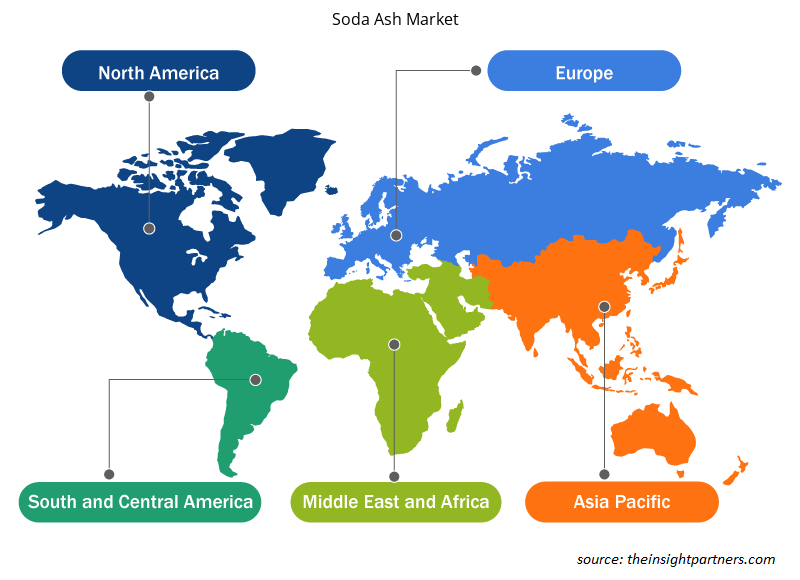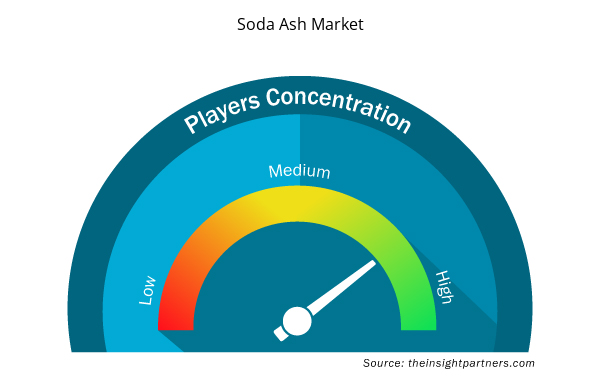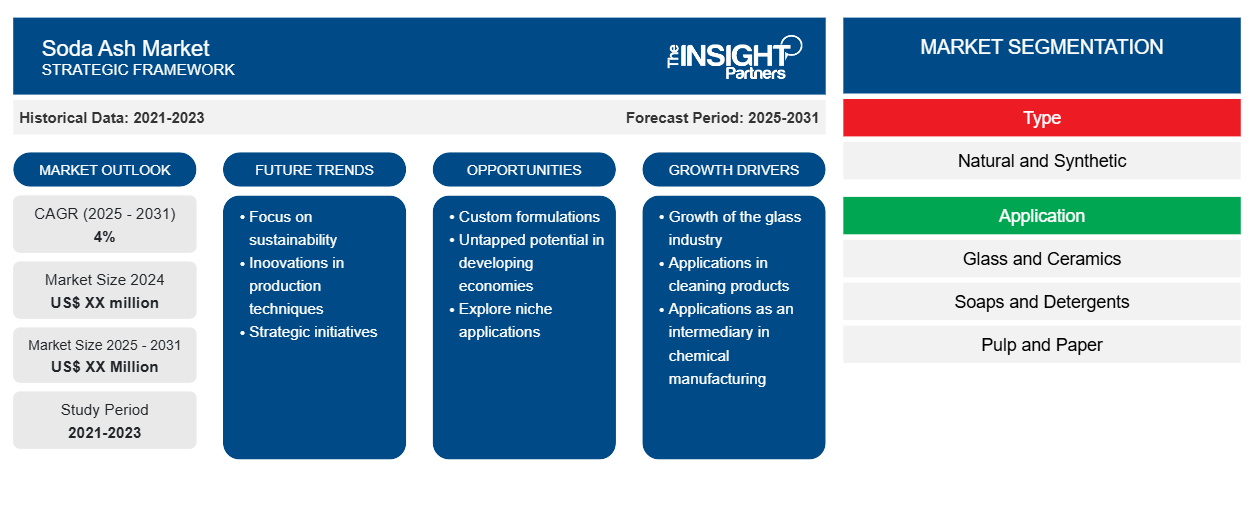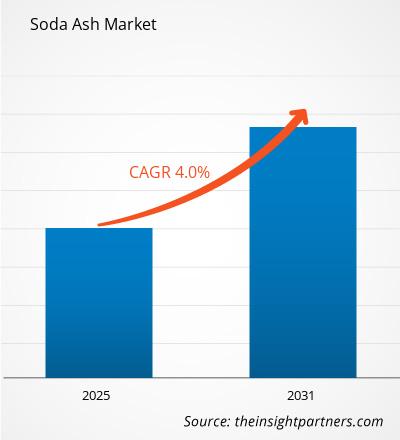Le marché du carbonate de sodium devrait enregistrer un TCAC de 4 % de 2024 à 2031, avec une taille de marché passant de XX millions USD en 2024 à XX millions USD d'ici 2031.
Le rapport est segmenté par type (naturel et synthétique). Le rapport présente en outre une analyse basée sur l'application (verre et céramique, savons et détergents, pâte et papier, textiles, produits chimiques et autres). L'analyse mondiale est ensuite décomposée au niveau régional et par principaux pays. La taille du marché et les prévisions aux niveaux mondial, régional et national pour tous les segments de marché clés sont couvertes dans le cadre du périmètre. Le rapport offre la valeur en USD pour l'analyse et les segments ci-dessus. Le rapport fournit des statistiques clés sur l'état du marché des principaux acteurs du marché et présente les tendances et les opportunités du marché.
Objectif du rapport
Le rapport Soda Ash Market de The Insight Partners vise à décrire le paysage actuel et la croissance future, les principaux facteurs moteurs, les défis et les opportunités. Cela fournira des informations à diverses parties prenantes commerciales, telles que :
- Fournisseurs/fabricants de technologie : pour comprendre l’évolution de la dynamique du marché et connaître les opportunités de croissance potentielles, leur permettant de prendre des décisions stratégiques éclairées.
- Investisseurs : Effectuer une analyse complète des tendances concernant le taux de croissance du marché, les projections financières du marché et les opportunités qui existent tout au long de la chaîne de valeur.
- Organismes de réglementation : Réglementer les politiques et surveiller les activités du marché dans le but de minimiser les abus, de préserver la confiance des investisseurs et de maintenir l’intégrité et la stabilité du marché.
Segmentation du marché du carbonate de sodium
Taper
- Naturel et synthétique
Application
- Verre et céramique
- Savons et détergents
- Pâtes et papiers
- Textiles
- Chimie et autres
Personnalisez ce rapport en fonction de vos besoins
Vous bénéficierez d'une personnalisation gratuite de n'importe quel rapport, y compris de certaines parties de ce rapport, d'une analyse au niveau des pays, d'un pack de données Excel, ainsi que d'offres et de remises exceptionnelles pour les start-ups et les universités.
- Obtenez les principales tendances clés du marché de ce rapport.Cet échantillon GRATUIT comprendra une analyse de données, allant des tendances du marché aux estimations et prévisions.
Facteurs de croissance du marché du carbonate de sodium
- Croissance de l'industrie du verre : L'industrie de la production de verre représente la plus grande part de l'utilisation du carbonate de sodium comme matière première principale. La production de verre augmente en raison de plusieurs facteurs, notamment la demande des industries de la construction, de l'automobile et du verre d'emballage. Tous ces facteurs se traduisent par une demande accrue de carbonate de sodium. Les niveaux d'urbanisation et de développement des infrastructures sont en hausse, en particulier dans les pays en développement. Dans ce cas, la demande de produits en verre devrait également augmenter, ce qui favorise la croissance du marché du carbonate de sodium.
- Applications dans les produits de nettoyage : Les détergents et les produits de nettoyage contiennent généralement du carbonate de sodium, car il adoucit l'eau, ce qui améliore la capacité de nettoyage. Cette tendance devrait se maintenir, propulsant ainsi le marché du carbonate de sodium en raison de son utilisation intensive dans la production de détergents.
- Applications comme intermédiaire dans la fabrication de produits chimiques : Le carbonate de sodium est un ingrédient essentiel pour la fabrication de produits tels que le carbonate de sodium, le bicarbonate de sodium et le silicate de sodium, entre autres produits chimiques. L'augmentation des activités industrielles, associée à l'expansion des produits chimiques spécialisés, alimente principalement le secteur de la fabrication de produits chimiques en pleine expansion, ce qui conduit à l'avancement du carbonate de sodium. Il semble y avoir une demande croissante de carbonate de sodium avec une tendance à explorer de nouveaux produits chimiques.
Tendances futures du marché du carbonate de sodium
- Focus sur la durabilité : Le marché du carbonate de sodium connaît une tendance à la hausse vers la durabilité. Les fabricants utilisent déjà des techniques écologiques dans le processus de production. Par exemple, l'inclusion de sources d'énergie renouvelables et le recyclage des déchets au cours des processus de production commencent à prendre forme. Les entreprises s'engagent davantage dans la minimisation de leurs émissions et de la dégradation de l'environnement, ce qui correspond aux stratégies contemporaines des industries et des consommateurs qui veulent des produits durables.
- Innovations dans les techniques de production : Les récentes améliorations des technologies de production contribuent également à l'efficacité et au coût peu élevé des opérations de fabrication du carbonate de sodium. Des améliorations telles que de meilleures techniques d'excavation, des systèmes de traitement et la robotique dans les usines de production permettent aux fabricants d'améliorer simultanément la production et de réduire les coûts. Ces développements technologiques sont fondamentaux pour répondre à la demande croissante de carbonate de sodium dans plusieurs industries utilisatrices finales.
- Initiatives stratégiques : Dans le secteur du carbonate de sodium, les activités de fusions et d'acquisitions stratégiques ont augmenté, car les entreprises cherchent à accroître leur part de marché et à améliorer la gamme de produits proposés. La stratégie consiste à acheter ou à fusionner avec une autre entreprise pour acquérir différentes ressources qui les aideront sur ce marché. Cela se produira probablement lorsque les entreprises chercheront à améliorer leurs capacités de production de carbonate de sodium.
Opportunités de marché pour le carbonate de sodium
- Formulations personnalisées : la demande de produits uniques à base de carbonate de sodium de la part des fabricants sur un marché concurrentiel est en hausse. Par exemple, une entreprise peut produire du carbonate de sodium spécifiquement conçu pour la production de verre à haute résistance et de savons et détergents de haute qualité. Le marché a besoin de ces produits à formulation unique. Les personnalisations spécifiques requises à des fins commerciales servent d'extension de leur offre et contribuent à accroître la fidélité de leur clientèle.
- Potentiel inexploité dans les économies en développement : Le marché du carbonate de sodium présente un potentiel de croissance important dans de nombreuses régions en développement, notamment en Asie-Pacifique, en Amérique latine et en Afrique. Ces régions, en particulier l'Asie, étant de plus en plus industrialisées et urbanisées, on s'attend à une augmentation de la demande de verre, de détergents et de produits chimiques. Ces territoires à forte croissance ont la possibilité de se développer activement en établissant des installations de production locales et en collaborant avec les canaux de distribution locaux.
- Explorez les applications de niche : En raison des propriétés uniques du carbonate de sodium, d'autres secteurs utilisant ce produit émergent. Ces secteurs peuvent inclure l'agriculture, la transformation des aliments et les produits pharmaceutiques. Par exemple, le carbonate de sodium a des applications dans les processus de traitement de l'eau, le contrôle du pH et comme agent tampon dans de multiples formulations. En conséquence, les fabricants peuvent élargir leur gamme de produits et augmenter leur part de marché sur les marchés qui demandent des matériaux avancés en étudiant ces différentes utilisations.
Aperçu régional du marché du carbonate de sodium
Les tendances et facteurs régionaux influençant le marché du carbonate de sodium tout au long de la période de prévision ont été expliqués en détail par les analystes d’Insight Partners. Cette section traite également des segments et de la géographie du marché du carbonate de sodium en Amérique du Nord, en Europe, en Asie-Pacifique, au Moyen-Orient et en Afrique, ainsi qu’en Amérique du Sud et en Amérique centrale.

- Obtenez les données régionales spécifiques au marché du carbonate de sodium
Portée du rapport sur le marché du carbonate de sodium
| Attribut de rapport | Détails |
|---|---|
| Taille du marché en 2024 | XX millions de dollars américains |
| Taille du marché d'ici 2031 | XX millions de dollars américains |
| Taux de croissance annuel composé mondial (2025-2031) | 4% |
| Données historiques | 2021-2023 |
| Période de prévision | 2025-2031 |
| Segments couverts | Par type
|
| Régions et pays couverts | Amérique du Nord
|
| Leaders du marché et profils d'entreprises clés |
|
Densité des acteurs du marché du carbonate de sodium : comprendre son impact sur la dynamique des entreprises
Le marché du carbonate de sodium connaît une croissance rapide, tirée par la demande croissante des utilisateurs finaux en raison de facteurs tels que l'évolution des préférences des consommateurs, les avancées technologiques et une plus grande sensibilisation aux avantages du produit. À mesure que la demande augmente, les entreprises élargissent leurs offres, innovent pour répondre aux besoins des consommateurs et capitalisent sur les tendances émergentes, ce qui alimente davantage la croissance du marché.
La densité des acteurs du marché fait référence à la répartition des entreprises ou des sociétés opérant sur un marché ou un secteur particulier. Elle indique le nombre de concurrents (acteurs du marché) présents sur un marché donné par rapport à sa taille ou à sa valeur marchande totale.
Les principales entreprises opérant sur le marché du carbonate de sodium sont :
- Solvay SA
- Tata Chemicals Limited
- Shandong Haihua Groupe Co. Ltd.
- Tronox Ltée.
- Nirma Ltée.
Avis de non-responsabilité : les sociétés répertoriées ci-dessus ne sont pas classées dans un ordre particulier.

- Obtenez un aperçu des principaux acteurs clés du marché du carbonate de sodium
Principaux arguments de vente
- Couverture complète : Le rapport couvre de manière exhaustive l’analyse des produits, des services, des types et des utilisateurs finaux du marché du carbonate de sodium, offrant un paysage holistique.
- Analyse d’experts : Le rapport est compilé sur la base d’une compréhension approfondie des experts et analystes du secteur.
- Informations à jour : Le rapport garantit la pertinence commerciale en raison de sa couverture des informations récentes et des tendances des données.
- Options de personnalisation : ce rapport peut être personnalisé pour répondre aux exigences spécifiques du client et s'adapter parfaitement aux stratégies commerciales.
Le rapport de recherche sur le marché du carbonate de sodium peut donc aider à ouvrir la voie au décodage et à la compréhension du scénario de l’industrie et des perspectives de croissance. Bien qu’il puisse y avoir quelques préoccupations valables, les avantages globaux de ce rapport ont tendance à l’emporter sur les inconvénients.
- Analyse historique (2 ans), année de base, prévision (7 ans) avec TCAC
- Analyse PEST et SWO
- Taille du marché Valeur / Volume - Mondial, Régional, Pays
- Industrie et paysage concurrentiel
- Ensemble de données Excel



Report Coverage
Revenue forecast, Company Analysis, Industry landscape, Growth factors, and Trends

Segment Covered
This text is related
to segments covered.

Regional Scope
North America, Europe, Asia Pacific, Middle East & Africa, South & Central America

Country Scope
This text is related
to country scope.
Questions fréquemment posées
Sustainable production practices is expected to be the key market trends
The report can be delivered in PDF/Word format, we can also share excel data sheet based on request.
On the basis of geography, the soda ash market is classified into North America, Europe, Asia Pacific, Middle East and Africa, and South and Central America
Growing demand from the glass industry is driving the market growth
Solvay; CIECH S.A.; Ciner Resources Corporatio; Tata Chemicals Ltd; GHCL Limited are some of the key players operating in the soda ash market
The Soda Ash Market is estimated to witness a CAGR of 4% from 2023 to 2031
Trends and growth analysis reports related to Chemicals and Materials : READ MORE..
The List Of Companies
- Solvay S. A.
- Tata Chemicals Limited
- Shandong Haihua Group Co. Ltd.
- Tronox Ltd.
- Nirma Ltd.
- Oriental Chemical Industries
- GHCL Ltd.
- FMC Corporation
- DCW Ltd.
- Ciech SA
The Insight Partners performs research in 4 major stages: Data Collection & Secondary Research, Primary Research, Data Analysis and Data Triangulation & Final Review.
- Data Collection and Secondary Research:
As a market research and consulting firm operating from a decade, we have published and advised several client across the globe. First step for any study will start with an assessment of currently available data and insights from existing reports. Further, historical and current market information is collected from Investor Presentations, Annual Reports, SEC Filings, etc., and other information related to company’s performance and market positioning are gathered from Paid Databases (Factiva, Hoovers, and Reuters) and various other publications available in public domain.
Several associations trade associates, technical forums, institutes, societies and organization are accessed to gain technical as well as market related insights through their publications such as research papers, blogs and press releases related to the studies are referred to get cues about the market. Further, white papers, journals, magazines, and other news articles published in last 3 years are scrutinized and analyzed to understand the current market trends.
- Primary Research:
The primarily interview analysis comprise of data obtained from industry participants interview and answers to survey questions gathered by in-house primary team.
For primary research, interviews are conducted with industry experts/CEOs/Marketing Managers/VPs/Subject Matter Experts from both demand and supply side to get a 360-degree view of the market. The primary team conducts several interviews based on the complexity of the markets to understand the various market trends and dynamics which makes research more credible and precise.
A typical research interview fulfils the following functions:
- Provides first-hand information on the market size, market trends, growth trends, competitive landscape, and outlook
- Validates and strengthens in-house secondary research findings
- Develops the analysis team’s expertise and market understanding
Primary research involves email interactions and telephone interviews for each market, category, segment, and sub-segment across geographies. The participants who typically take part in such a process include, but are not limited to:
- Industry participants: VPs, business development managers, market intelligence managers and national sales managers
- Outside experts: Valuation experts, research analysts and key opinion leaders specializing in the electronics and semiconductor industry.
Below is the breakup of our primary respondents by company, designation, and region:

Once we receive the confirmation from primary research sources or primary respondents, we finalize the base year market estimation and forecast the data as per the macroeconomic and microeconomic factors assessed during data collection.
- Data Analysis:
Once data is validated through both secondary as well as primary respondents, we finalize the market estimations by hypothesis formulation and factor analysis at regional and country level.
- Macro-Economic Factor Analysis:
We analyse macroeconomic indicators such the gross domestic product (GDP), increase in the demand for goods and services across industries, technological advancement, regional economic growth, governmental policies, the influence of COVID-19, PEST analysis, and other aspects. This analysis aids in setting benchmarks for various nations/regions and approximating market splits. Additionally, the general trend of the aforementioned components aid in determining the market's development possibilities.
- Country Level Data:
Various factors that are especially aligned to the country are taken into account to determine the market size for a certain area and country, including the presence of vendors, such as headquarters and offices, the country's GDP, demand patterns, and industry growth. To comprehend the market dynamics for the nation, a number of growth variables, inhibitors, application areas, and current market trends are researched. The aforementioned elements aid in determining the country's overall market's growth potential.
- Company Profile:
The “Table of Contents” is formulated by listing and analyzing more than 25 - 30 companies operating in the market ecosystem across geographies. However, we profile only 10 companies as a standard practice in our syndicate reports. These 10 companies comprise leading, emerging, and regional players. Nonetheless, our analysis is not restricted to the 10 listed companies, we also analyze other companies present in the market to develop a holistic view and understand the prevailing trends. The “Company Profiles” section in the report covers key facts, business description, products & services, financial information, SWOT analysis, and key developments. The financial information presented is extracted from the annual reports and official documents of the publicly listed companies. Upon collecting the information for the sections of respective companies, we verify them via various primary sources and then compile the data in respective company profiles. The company level information helps us in deriving the base number as well as in forecasting the market size.
- Developing Base Number:
Aggregation of sales statistics (2020-2022) and macro-economic factor, and other secondary and primary research insights are utilized to arrive at base number and related market shares for 2022. The data gaps are identified in this step and relevant market data is analyzed, collected from paid primary interviews or databases. On finalizing the base year market size, forecasts are developed on the basis of macro-economic, industry and market growth factors and company level analysis.
- Data Triangulation and Final Review:
The market findings and base year market size calculations are validated from supply as well as demand side. Demand side validations are based on macro-economic factor analysis and benchmarks for respective regions and countries. In case of supply side validations, revenues of major companies are estimated (in case not available) based on industry benchmark, approximate number of employees, product portfolio, and primary interviews revenues are gathered. Further revenue from target product/service segment is assessed to avoid overshooting of market statistics. In case of heavy deviations between supply and demand side values, all thes steps are repeated to achieve synchronization.
We follow an iterative model, wherein we share our research findings with Subject Matter Experts (SME’s) and Key Opinion Leaders (KOLs) until consensus view of the market is not formulated – this model negates any drastic deviation in the opinions of experts. Only validated and universally acceptable research findings are quoted in our reports.
We have important check points that we use to validate our research findings – which we call – data triangulation, where we validate the information, we generate from secondary sources with primary interviews and then we re-validate with our internal data bases and Subject matter experts. This comprehensive model enables us to deliver high quality, reliable data in shortest possible time.


 Obtenez un échantillon gratuit pour ce rapport
Obtenez un échantillon gratuit pour ce rapport